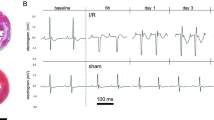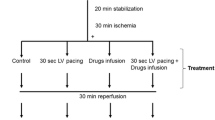Abstract
The present study provides evidences of left ventricular diastolic alterations following reperfusion in a model of global ischemia. Isolated perfused rabbit and rat hearts, were subjected to ischemia for 15 and 20 min respectively, followed by 30 min of reperfusion. In rabbit heart at the end of the reperfusion period, isovolumic left ventricular developed pressure (LVDP) and +dP/dtmax stabilized at 55 ± 3% and 60 ± 2% of preischemic values respectively and, in rat heart LVDP = 61 ± 8% and +dP/dtmax = 57 ± 9% of preischemic values. Stunned heart was then obtained from both species. Left ventricular end diastolic pressure (LVEDP) values stabilized at the end of reperfusion period at values higher than preischemic conditions in both species (38.9 ± 4.4 mmHg and 30.3 ± 3.1 mmHg in rabbit and rat respectively). The time constant of relaxation (T) increased early in reperfusion in both species, but then decreased and stabilized at the end of reperfusion period at values lower than preischemic values. The ratio between both maximal velocities (+P/-P), also showed a transitory impairment in relaxation, followed by normalization and stabilization at values lower than preischemic values. This biphasic pattern in relaxation was detected in both species. The changes in relaxation were dissociated from the diastolic compliance and could be the result of a transitory calcium overload and/or sarcoplasmic reticulum dysfunction. The faster myocardial relaxation at the end of reperfusion period is consistent with the decreased myofilament sensitivity, which characterizes the stunned myocardium.
Similar content being viewed by others
References
Heydrinckx G, Millard RW, McRitchie RJ, Maroko PR, Vatner SF: Regional myocardial function and electrophysiologic alterations after brief coronary artery occlusions in conscious dogs. J Clin Invest 56: 978–985, 1975
Kloner RA, DeBoer LWV, Darsee JR, Ingwall JS, Hale S, Tumas J, Braunwald E: Prolonged abnormalities of myocardium salvaged by reperfusion. Am J Physiol 241 (Heart Circ Physiol 10): H591-H599, 1981
Braunwald E, Kloner R: The stunned myocardium: prolonged, postischemic ventricular dysfunction. Circulation 66: 1146–1149, 1982
Kusuoka H, Koretsune Y, Chacko VP, Weisfeldt ML, Marban E: Excitation-contraction coupling in postischemic myocardium. Does failure of activator Ca2+ transient underlie stunning? Circ Res 66: 1268–1276, 1990
Lee JA, Allen DG: Changes in intracellular free calcium concentration duringlong exposures to stimulated ischemia in isolated mammalian ventricular muscle. Circ Res 71: 58–69, 1992
Carrozza JP, Bentivegna LA, Williams ChP et al.: Decreased myofilament responsiveness in myocardial stunning follows transient calcium overload during ischemia and reperfusion. Circ Res 71: 1334–1340, 1992
Hofmann PA, Miller WP, Moss RL: Altered calcium sensitivity of isometric tension in myocyte-sized preparations of porcine postischemic stunned myocardium. Circ Res 72: 50–56, 1993
Blinks JR, Endoh M: Modification of myofibrillar responsiveness to Ca2+ as an inotropic mechanism. Circulation 73, Suppl III: III-85-III-98, 1986
Jeremy RW, Koretsune Y, Marban E, Becker LC: Relation between glycolisis and calcium homeostasis in postischemic myocardium. Circ Res 70: 1180–1190, 1992
Eberli FR, Weinberg EO, Grice WN, Horowitz GL, Apstein CS: Protective effect of increased glycolitic substrate against systolic and diastolic dysfunction and increased coronary resistance from prolonged global underperfusion and reperfusion in isolated rabbit hearts perfused with erythrocyte suspensions. Circ Res 68: 466–481, 1991
Marban E, Kitakaze M, Koretsune Y, Yue DT, Chacko VP, Pike MM: Quantification of [Ca2+] in perfused hearts: Critical evaluation of the 5F-BAPTA and nuclear magnetic resonance method as applied to the study of ischemia and reperfusion. Circ Res 66: 1255–1267, 1990
Gao WD, Atar D, Backx PH, Marban E: Relationship between intracellular calcium and contractile force in stunned myocardium. Direct evidence for decreased myofilament Ca2+ responsiveness and altered diastolic function in intact ventricular muscle. Circ Res 76: 1036–1048, 1995
Charlat M, O'Neill P, Hartley C, Roberts R, Belli R: Prolonged abnormalities of left ventricular diastolic wall thinning in the ‘stunned’ myocardium in conscious dogs: time course and relation to systolic function. J Am Coll Cardiol 13: 185–194, 1989
Przylenk K, Patel B, Kloner RA: Diastolic abnormalities of postischemic ‘stunned’ myocardium. Am J Cardiol 60: 1211–1213, 1987
Apstein CS, Bing OHL, Levine HJ: Acute cardiac ischemia and reperfusion: contractility, relaxation, and glycolisis. Am J Physiol 235: H637-H643, 1978
Lew WYW, Nishikawa Y, Su H: Cardiac myocyte function and left strains after brief ischemia and reperfusion in rabbits. Circulation 90: 1942–1950, 1994
Jennings R, Schaper J, Hill M: Effect of reperfusion late in the phase of reversible ischemic injury: changes in cell volume, electrolytes, metabolites and ultrastructure. Circ Res 56: 262–268, 1985
Walker DM, Marber MS, Walker JM, Yellon DM: Preconditioning in isolated superfused rabbit papillary muscles. Am J Physiol 266 (Heart Circ Physic] 35): H1534-H1540, 1994
Weiss RG, Kalil-Filho R, Herskowitz A, Chacko VP, Litt M, Stern MD, Gerstenblith G: Tricarboxylic acid cycle activity in postischemic rat hearts. Circulation 87: 270–282, 1993
Asimakis GK, Inners-McBride K, Medellin G, Conti VR: Ischemic preconditioning attenuates acidosis and post-ischemic dysfunction in isolated rat heart. Am J Physiol 263: H887-H894, 1992
Lasley RD, Anderson GM, Mentzer RM: Ischemic and hypoxic preconditioning enhance post-ischemic recovery of function in the rat heart. Cardiovasc Res 27: 565–570, 1993
Momomura S, Izuka T, Serizawa T, Sugimoto I: Separation of rate of left ventricular relaxation from changes stiffness in rats. Am J Physiol 24: 1468–1476, 1988
Wallenstein S, Zucker CL, Fleiss JL: Some statistical methods useful in circulation research. Circ Res 47: 1–9, 1980
Kingsley PB, Sako EY, Yang MQ, Zimmer SD, Ugurbil K, Foker JE, From AHL: Ischemic contracture begins when anaerobic glycolisis stops: a31P-NMR study of isolated rat hearts. Am J Physiol 261: H469-H478, 1991
Griffiths EJ, Halestrap AP: Protection by ciclosporin A of ischemia/reperfusion-induced damage in isolated rat hearts. J Mol Cell Cardiol 25: 1461–1469, 1993
Grassi de Gende AO, Pérez Alzueta AD, Cingolani HE: Effect of isoproterenol on relation between maximal rate of contraction and maximal rate of relaxation. Am J Physiol 2: H404-H409, 1977
Vittone L, Cingolani HE, Mattiazzi RA: The link between myocardial contraction and relaxation: The effects of calcium antagonists. J Mol Cell Cardiol 17: 255–263, 1981
Mattiazzi RA, Garay A, Cingolani HE: Critical evaluation of isometric indexes of relaxation in rat and cat papillary muscles and toad ventricular strips. J Mol Cell Cardiol 18: 749–758, 1986
Vittone L, Mundiña-Weilenmann C., Mattiazzi RA, Cingolani HE: Physiologic and pharmacologic factors that affect myocardial relaxation. JPM 32(1): 7–18, 1994
Meissner A, Morgan JP: Contractile dysfunction and abnormal Ca2+ modulation during postischemic reperfusion in rat heart. Am J Physiol 268 (Heart Circ Physiol 37): H100-H111, 1995
Mosca SM, Gelpi RJ, Cingolani HE: Dissociation between myocardial relaxation and diastolic stiffness in the stunned heart: its prevention by ischemic preconditioning. Mol Cell Biochem 129: 171–178, 1993
Marban E, Koretsune Y, Corretti MC, Chacko VP, Kusuoka H: Calcium and its role in myocardial cell injury during ischemia and reperfusion. Circulation 80 (suppl IV): 17–22, 1989
Kusuoka H, Marban E: Cellular mechanisms of myocardial stunning. Ann Rev Physiol 54: 243–56, 1992
Kusuoka H, Kitakaze M, Koretsune Y, Inoue M, Marban E: Pathophysiology and pathogenesis of contractile failure in stunned myocardium. Jpn Circ J 55: 878–884, 1991
Kihara Y, Grossman W, Morgan JP: Direct measurement of changes in intracellular calcium transients during hipoxia, ischemia and reperfusion of the intact mammalian heart. Circ Res 65: 1029–1044, 1989
Steenbergen C, Murphy E, Levy L, London RE: Elevation in cytosolic free calcium concentration early in myocardial ischemia in perfused rat heart. Circ Res 60: 700–707, 1987
Mohabir R, Lee HK, Kurz RW, Clusin WT: Effects of ischemia and hypercarbic acidosis on myocyte calcium transients, contraction, and pHi, in perfused rabbit hearts. Circ Res 69: 1525–1537, 1991
Steenbergen C, Murphy E, Watts JA, London RE: Correlation between cytosolic free calcium, contracture, ATP, and irreversible ischemic injury in perfused rat heart. Circ Res 66: 135–146, 1990
Krause SM, Jacobus WE, Becker LC: Alterations in cardiac sarcoplasmic reticulum calcium transport in the postischemic ‘stunned’ myocardium. Circ Res 65: 526–530, 1989
Davis MD, Lebolt W, Feher JJ: Reversibility of the effects of normothermic global ischemia on the ryanodine-sensitive and ryanodineinsensitive calcium uptake of cardiac sarcoplasmic reticulum. Circ Res 70: 163–71, 1992
Philipson KD, Bersohn MM, Nishimoto AY: Effects of pH on Na+-Ca2+ exchange and Ca2+ permeability of cardiac sarcolemmal vesicles. J Biol Chem 258: 5905–5910, 1982
Philipson KD, Nishimoto AY: Na+-Ca2+-exchange in inside-out cardiac sarcolemmal vesicles. J Biol Chem 257: 5111–5117, 1982
Tani M: Mechanisms of Ca2+ overload in reperfused ischemic myocardium. Ann Rev Physiol 52: 543–59, 1990
Kusuoka H, Camilión de Hurtado MC, Marban E: Role of Na+/Ca2+ exchanger in the mechanism of stunning: Protective effect of reperfusion with high sodium solution. J Am Coll Cardiol 21: 240–248, 1993
Pike M, Kitakaze M, Marban E: Na-NMR measurements of intracellular sodium in intact ferret hearts during ischemia and reperfusion. Am J Physiol 259: H1767-H1773, 1990
Author information
Authors and Affiliations
Rights and permissions
About this article
Cite this article
Mosca, S.M., Carriquiriborde, M. & Cingolani, H.E. Biphasic changes in relaxation following reperfusion after myocardial ischemia. Mol Cell Biochem 160, 123–128 (1996). https://doi.org/10.1007/BF00240041
Issue Date:
DOI: https://doi.org/10.1007/BF00240041




